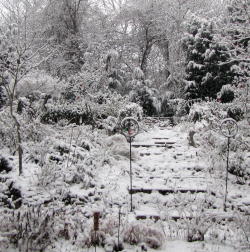 Paths and walkways are a must in my hilly garden. There are lots of pros to the slope though. You can see the plantings eye to eye as you meander along the chosen paths. The paths seemed to place themselves, where the best route to get from here to there became apparent. This flowering quince, very old fashioned, never lets me down in the spring.
Paths and walkways are a must in my hilly garden. There are lots of pros to the slope though. You can see the plantings eye to eye as you meander along the chosen paths. The paths seemed to place themselves, where the best route to get from here to there became apparent. This flowering quince, very old fashioned, never lets me down in the spring.
 To begin our walk we come out of the back door where the containers live. I usually turn right here.
To begin our walk we come out of the back door where the containers live. I usually turn right here.

And we come up the stairs at the far right end of the big wall to get to the first level. This is where the pond is. More to come about that later. After searching for the perfect stepping pavers, it was decided to make our own. Each paver is one forty pound bag of quickcrete, mixed and poured into a form we made from two by fours that is sixteen by fifteen inches, measured for a human foot to fit onto. Maple leaves and black river rock were placed on top of the paver when wet to dress them up a bit.
 Continuing on to the first set of steps to get to the next level. These were made the same way as the stepping pavers, but were much harder since they took many bags of quickcrete. Without them we just slid down the hill while trying to get to the top. An amusing sight. Ajuga, cerestium, (snow in summer) and golden creeping jenny, along with the original planting of doone valley thyme are growing along the risers and sides, with some dianthus that is losing the battle of the groundcovers.
Continuing on to the first set of steps to get to the next level. These were made the same way as the stepping pavers, but were much harder since they took many bags of quickcrete. Without them we just slid down the hill while trying to get to the top. An amusing sight. Ajuga, cerestium, (snow in summer) and golden creeping jenny, along with the original planting of doone valley thyme are growing along the risers and sides, with some dianthus that is losing the battle of the groundcovers.
 If you go past the concrete steps instead of climbing them there is a small group of rocks placed as steps. I am a firm believer in having many ways to get to a place. It’s all about choices. Planted here we find scotch moss, barlow black columbine, lamb’s ear, bath’s pink dianthus, golden edger hosta and hermann’s pride lamium.
If you go past the concrete steps instead of climbing them there is a small group of rocks placed as steps. I am a firm believer in having many ways to get to a place. It’s all about choices. Planted here we find scotch moss, barlow black columbine, lamb’s ear, bath’s pink dianthus, golden edger hosta and hermann’s pride lamium.
 Going up from the middle terrace at the east end you see the shed. The dianthus firewitch is filling in nicely. Boxwood wintergreen has been started from cuttings to give the bed by the path some shape and keep plants from flopping. Flopping is sometimes a problem in these paths. This used to be an iris bed, but they were not performing to expectations and have been replaced with blackberry lilies, stipa grass, eryngium, helenium and whatever decides it wants to live there. The top level of the garden is the knot garden. There is a raised planter behind the shed now planted with blueberries. It used to have tomatoes but the hemlocks have grown so large that it is now too shady for those.
Going up from the middle terrace at the east end you see the shed. The dianthus firewitch is filling in nicely. Boxwood wintergreen has been started from cuttings to give the bed by the path some shape and keep plants from flopping. Flopping is sometimes a problem in these paths. This used to be an iris bed, but they were not performing to expectations and have been replaced with blackberry lilies, stipa grass, eryngium, helenium and whatever decides it wants to live there. The top level of the garden is the knot garden. There is a raised planter behind the shed now planted with blueberries. It used to have tomatoes but the hemlocks have grown so large that it is now too shady for those.
 Looking back from the last spot you see the big steps in the middle flanked by the swan planters and the dianthus. The pavers lead to a dead end at the chain link fence. There was a pine tree there that died. Two japanese maple seedlings are being coddled there for future shade. Fothergilla is the latest attemt to hide the fence. Originally rhododendrens were placed there. Interestingly, the dianthus bath’s pink and firewitch have been havings relations and many new colorations have occurred in their progeny.
Looking back from the last spot you see the big steps in the middle flanked by the swan planters and the dianthus. The pavers lead to a dead end at the chain link fence. There was a pine tree there that died. Two japanese maple seedlings are being coddled there for future shade. Fothergilla is the latest attemt to hide the fence. Originally rhododendrens were placed there. Interestingly, the dianthus bath’s pink and firewitch have been havings relations and many new colorations have occurred in their progeny.
 We are now entering the part of the garden obtained when buying the house next door. This garden was begun a year later than the first area behind the main house. You can see the garage loft and deck from here. We now switched to gravel paths lined on either side with rocks. This material is easier to walk on in some ways because you don’t have to watch your step so you don’t slip off the edge. Newcomers have sometimes done that and I have to remind them to look down instead of looking at the flowers. Not a good thing. So far no one has fallen! I said before you have to have a little hillbilly in you to garden here. It is true.
We are now entering the part of the garden obtained when buying the house next door. This garden was begun a year later than the first area behind the main house. You can see the garage loft and deck from here. We now switched to gravel paths lined on either side with rocks. This material is easier to walk on in some ways because you don’t have to watch your step so you don’t slip off the edge. Newcomers have sometimes done that and I have to remind them to look down instead of looking at the flowers. Not a good thing. So far no one has fallen! I said before you have to have a little hillbilly in you to garden here. It is true.
 Moving on you can see the path is not level. That is an upcoming project to remedy. On the deck side of these beds is a group of heathers, both calluna and erica with some magic carpet spireas. I wanted to keep it low so the view from the deck would be as expansive as possible. The edging on the right side is wooly yarrow and a dwarf ribbon grass. Blue fescue is used wherever I want to keep weeds out while I figure out what to plant. It needs dividing yearly to look pretty so there is a constant supply. You can see it around the little copper bowl used for the birds to have water placed on a flue tile.
Moving on you can see the path is not level. That is an upcoming project to remedy. On the deck side of these beds is a group of heathers, both calluna and erica with some magic carpet spireas. I wanted to keep it low so the view from the deck would be as expansive as possible. The edging on the right side is wooly yarrow and a dwarf ribbon grass. Blue fescue is used wherever I want to keep weeds out while I figure out what to plant. It needs dividing yearly to look pretty so there is a constant supply. You can see it around the little copper bowl used for the birds to have water placed on a flue tile.

A winter shot of the continuation on to the east boundary of the garden. This property came with iron clothesline poles. On the closest one is a moonlight rose and fortissima rose wound together. Moonlight is much more vigorous with its repeating white blooms, but just a few of the reds of its companion rose give lots of punch to the scene. Also seen here on the left are rosemary shrubs. They get unexpectedly huge here and have to be pruned hard, what a pleasant task though with that resin so wonderfully fragrant.

Looking back, suddenly it’s early spring! Blue muscari and my earliest daffodil, inherited with the neighbor house are giving some contrast to the blooming heathers on the right. Growing on the tall metal poles are butterfly bush standards. They are Potter’s purple, honeycomb and royal red.

At the end of the lot corner is the other clothesline pole planted with a rose we used to have growing on the front of the house on an arbor. It is Alberic Barbier from the Antique Rose Emporium. I wanted a fast growing climber and this is it. We had to move it from the front because it was eating our house. The contractor said the metal roof we had installed would be too hot for it to grow up the roof. Not so. The plant shown here is a piece that had rooted in the gutters in the leaf humus. We call this rose Killer. Killer is going to have a large arbor built for it this year. One cane can easily grow twenty feet in one year. It is very thorny. Talk about a burglar deterrent. Anyway, also growing here is a double flowered kerria in bloom and crossvine tangerine beauty with killer on the pole.
 Coming on down past more rosemary bushes is what we call the flat area. There really is no place that is flat here. This used to be the driveway and parking for the house that was demolished . Talk about poor soil. We added mushroom compost a couple of years ago but that is about gone. This bright lights swiss chard seems to be able to grow here and gives nice color. I rip it out in spring because it goes to seed and is unlovely then. I built a raised planter here that is sixteen inches high since this photo was taken. I have been filling it with chopped leaves. It should be a good spot someday for babying things.
Coming on down past more rosemary bushes is what we call the flat area. There really is no place that is flat here. This used to be the driveway and parking for the house that was demolished . Talk about poor soil. We added mushroom compost a couple of years ago but that is about gone. This bright lights swiss chard seems to be able to grow here and gives nice color. I rip it out in spring because it goes to seed and is unlovely then. I built a raised planter here that is sixteen inches high since this photo was taken. I have been filling it with chopped leaves. It should be a good spot someday for babying things.

Past the garage and down to the driveway we go. Blue star junipers, a pink dogwood, bulbs and a japanese maple that had to be replaced due to an untimely frost death appear here. The maple is out, in is a black lace sambucus.
 At the driveway as you enter the path this year I planted four pentas. I can see this spot from the kitchen sink window and it brightened the dish washing chores to look at the butterflies hovering this summer. Plant more of that next year.
At the driveway as you enter the path this year I planted four pentas. I can see this spot from the kitchen sink window and it brightened the dish washing chores to look at the butterflies hovering this summer. Plant more of that next year.

Beyond the garage and past the front door to the neglected side of the house where the central air unit is located. The dogwood seedlings, just inches tall, planted in 1996 are now tall and flowering. Daylilies, hosta royal standard, peonies and the ever present violets live here. I know, I know, it needs attention. It is on the list.









How delightful–we get to see your paths and you treat us to a tour of the whole garden at the same time! It’s really amazing what you’ve done with the site, Frances.
Nan…thanks for your support. I am looking forward to the next topic for the designers workshops. Any hints?
Frances your garden is beautiful. I like the way you have paths and steps all around. A good use for clothes line poles too.
Wonderful tour of your garden. I can’t imagine having that much gardening space. You’ve obviously put in many, many hours of hard labor with all of that concrete and stone work.
Pam @ Digging says:
Frances, you were really raring to go with a blog, weren’t you? 🙂
Your “Killer” is a beauty. It’s nice that it will have a place soon where it can do its thing. Gardening on a steep slope like yours must be very challenging, but you’ve done so much with it. Your garden looks great.
Lisa….thanks. The clothesline poles give the garden that folksy touch, no? ha ha.
robin’s nesting place… the concrete and work was hard physical labor. It happened very gradually, over several years.
Pam…more pictures to come of the infamous Killer. How do you respond to comments under their initial posting in italics?
Pam @ Digging says:
Frances, my WordPress blog allows me to edit comments, so I just select “edit” and then type my reply beneath each comment. I can italicize it with a text tool option. Maybe Blogger works the same way?
My Word! What a beautiful garden! You must spend all your free time in it!
Hi again, Frances! I can’t give you a hint about the next topic for the Garden Bloggers’ Design Workshop, because I haven’t selected it yet. But I’m open to requests!
France, thank you for this tour in your garden – it felt great.
I am also very impresses with your garden – such big space arranged so lovely. Must have being a lot of work.
Ewa…Thanks for clicking on the link to see the older posts. The making of this garden has been a lot of work, it is true, but it is a labor of love. There is nothing else I would rather be doing than working in the garden.